Astérix theme by jéjé
Download: Asterix.p3t
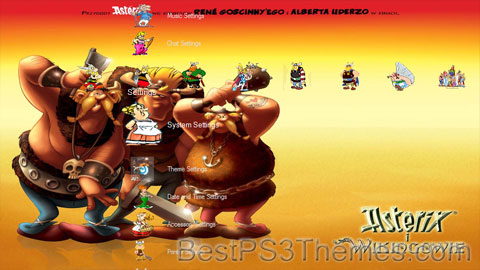
(2 backgrounds)
Redirect to:

The #1 spot for Playstation themes!
Saint Seiya theme by jéjé
Download: SaintSeiya.p3t
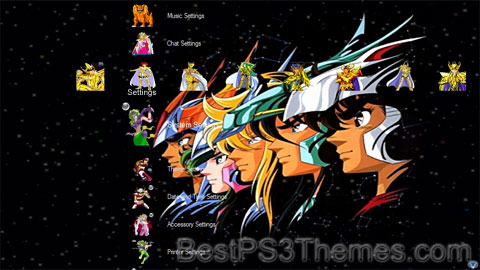
(1 background)
| Saint Seiya | |||||||||||||||||||||||||||||||||||||||||||||||||||||||||||||||||||||||||||||||||||||||||||
 First tankōbon volume cover, featuring Pegasus Seiya | |||||||||||||||||||||||||||||||||||||||||||||||||||||||||||||||||||||||||||||||||||||||||||
| 聖闘士星矢 (Seinto Seiya) | |||||||||||||||||||||||||||||||||||||||||||||||||||||||||||||||||||||||||||||||||||||||||||
|---|---|---|---|---|---|---|---|---|---|---|---|---|---|---|---|---|---|---|---|---|---|---|---|---|---|---|---|---|---|---|---|---|---|---|---|---|---|---|---|---|---|---|---|---|---|---|---|---|---|---|---|---|---|---|---|---|---|---|---|---|---|---|---|---|---|---|---|---|---|---|---|---|---|---|---|---|---|---|---|---|---|---|---|---|---|---|---|---|---|---|---|
| Genre | |||||||||||||||||||||||||||||||||||||||||||||||||||||||||||||||||||||||||||||||||||||||||||
| Manga | |||||||||||||||||||||||||||||||||||||||||||||||||||||||||||||||||||||||||||||||||||||||||||
| Written by | Masami Kurumada | ||||||||||||||||||||||||||||||||||||||||||||||||||||||||||||||||||||||||||||||||||||||||||
| Published by | Shueisha | ||||||||||||||||||||||||||||||||||||||||||||||||||||||||||||||||||||||||||||||||||||||||||
| English publisher | |||||||||||||||||||||||||||||||||||||||||||||||||||||||||||||||||||||||||||||||||||||||||||
| Imprint | Jump Comics | ||||||||||||||||||||||||||||||||||||||||||||||||||||||||||||||||||||||||||||||||||||||||||
| Magazine |
| ||||||||||||||||||||||||||||||||||||||||||||||||||||||||||||||||||||||||||||||||||||||||||
| Demographic | Shōnen | ||||||||||||||||||||||||||||||||||||||||||||||||||||||||||||||||||||||||||||||||||||||||||
| Original run | December 12, 1985 – December 12, 1990 | ||||||||||||||||||||||||||||||||||||||||||||||||||||||||||||||||||||||||||||||||||||||||||
| Volumes | 28 | ||||||||||||||||||||||||||||||||||||||||||||||||||||||||||||||||||||||||||||||||||||||||||
| |||||||||||||||||||||||||||||||||||||||||||||||||||||||||||||||||||||||||||||||||||||||||||
Saint Seiya (Japanese: 聖闘士星矢, Hepburn: Seinto Seiya), also known as Saint Seiya: Knights of the Zodiac or simply Knights of the Zodiac (translated from the French title Les Chevaliers du Zodiaque),[5] is a Japanese manga series written and illustrated by Masami Kurumada. It was serialized in Shueisha's shōnen manga magazine Weekly Shōnen Jump from 1985 to 1990, with its chapters collected in 28 tankōbon volumes. The story follows five mystical warriors called the Saints who fight wearing sacred sets of armor named "Cloths", the designs of which derive from the various constellations the characters have adopted as their destined guardian symbols. The Saints have sworn to defend the reincarnation of the Olympian goddess Athena (in her fictional depiction specific to the series) in her battle against other gods who want to dominate Earth.
In North America, the manga was licensed for English release by Viz Media. Since 2006, Kurumada has been publishing a sequel manga titled Saint Seiya: Next Dimension. Several spin-off manga by different authors have also been created. The manga was adapted by Toei Animation into a 114-episode anime television series which was broadcast on TV Asahi from 1986 to 1989. Saint Seiya was later continued with three original video animations released from 2002 to 2008. Four animated feature films premiered in Japanese theaters from 1987 to 1989, with a fifth in 2004 and a sixth in 2014. A live-action film adaptation premiered in April 2023.
The Saint Seiya manga had over 50 million copies in circulation as of 2022, making it one of the best-selling manga series of all time. Both the original manga and the anime adaptation were successful internationally across Asia, Europe, and Latin America.
The story focuses on an orphan named Seiya who was forced to go to the Sanctuary in Greece to obtain one of the "Cloths" (聖衣, Kurosu), the Bronze Cloth of the Pegasus constellation, a protective armor worn by the Greek goddess Athena's 88 warriors known as "Saints" (聖闘士, Seinto, or "Knights" in some adaptations). Upon awakening his "Cosmo" (小宇宙, Kosumo, lit. "mini-cosmos" or "mini-universe"), Seiya acquires the ability to unleash the true power of a Saint through what is variously described as the "burning", "explosion", or "big bang" of his "Cosmo" (alluding to the Big Bang of the universe). He then quickly becomes the Pegasus Saint and returns to Japan to find his older sister.
Because his sister disappeared the same day Seiya went to the Sanctuary, Saori Kido, the adopted granddaughter of Mitsumasa Kido (the person who sent all the orphans to train) makes a deal with him to go to fight in a tournament called the Galaxian Wars. In this tournament, all the orphans who survived and became Bronze Saints must fight to win the most powerful Cloth: The Sagittarius Gold Cloth. If Seiya goes to compete there and wins, Saori would start a search to find Seiya's sister. The tournament is interrupted by the vengeful Phoenix Bronze Saint, Ikki, who wishes to eliminate the people who forced him to undergo his especially harsh training. He steals parts from the Sagittarius Cloth and eventually fights against the remaining Bronze Saints: Seiya, Shun (Ikki's brother), Shiryū, and Hyōga.
Upon Ikki's defeat, the Bronze Saints are attacked by the Silver Saints sent by the Sanctuary's corrupt Pope to eliminate them. When they prevail, the Bronze Saints learn that Saori is Athena's reincarnation and that the Pope once tried to kill her as a baby. The previous Sagittarius Gold Saint Aiolos saved Saori but was mortally wounded shortly after escaping and gave Saori to her adopted grandfather. Deciding to join forces with Saori, the Bronze Saints go to the Sanctuary to defeat the Pope, but upon their arrival, Saori is severely wounded by a gold arrow from a Silver Saint and will die at the end of the day. Believing the Pope may be able to heal her, the Bronze Saints go to find him. To do so, they must go through 12 temples, each one guarded by one Gold Saint (the most powerful Saints of Athena). Some of these Gold Saints are friendly, but others are just as corrupt as the Pope and take a sick pleasure in fighting the Bronze Saints. Following several battles, Seiya gets to the Pope's temple and learns that he is actually the Gold Saint Gemini Saga, who suffers from a split personality: one good and one evil. His evil side took over completely and had killed the real Pope to obtain more power. With help from his friends' Cosmos, Seiya is able to knock out Saga and use the shield from Athena's statue to heal Saori just in time. Shortly afterwards, Saga, his good side having regained control, commits suicide as a self-punishment.
In the second story arc, the Greek god Poseidon reincarnates within the body of Julian Solo, the heir to a rich and powerful family, and plots to flood the Earth. Saori goes to his Temple, where Julian offers her to reduce the flooding by absorbing the water inside the Oceans' Central Pillar. Following Saori, Seiya, Hyōga, Shun and Shiryū go to Poseidon's underwater Temple and are confronted by his underlings, the Marines. As Seiya, Hyōga, and Shiryū make their way to Julian, Ikki learns that the mastermind behind this conflict is Saga's twin brother, Gemini Kanon, who is manipulating Poseidon. During the final battle, Poseidon's spirit awakes within Julian and manages to defeat his opponents. Saved by the Saints from the Pillar, Saori seals Poseidon's soul within her amphora.
The third and last arc follows how Hades, the Underworld god, is freed from his seal and revives the deceased Gold Saints and the Pope Aries Shion, and alongside some of his 108 Specters, sends them to the Sanctuary to kill Athena. The remaining Gold Saints serving Athena are able to subdue the enemies, but Saori then commits suicide. This act is instead meant to directly send her to the Underworld to face Hades, and the Bronze Saints follow her. Shion reveals that the revived Gold Saints' true intentions were of giving Saori her own Cloth so she could fight alongside her knights, and gives it to Seiya's group before dying once again. In the Underworld, as the Saints fight Hades' Specters, Shun is possessed by Hades. Saori reaches Hades and expels his soul from Shun's body. Hades then takes Saori to Elysium, and the five Bronze Saints follow them. In the final fight against Hades and his two subordinates, the gods Hypnos and Thanatos, the Saints gain the all-powerful God Cloths and use them to aid Saori in defeating Hades. However, Seiya also sacrifices himself by receiving one of Hades' attacks, and the Saints return to Earth with his body.
At first, Kurumada planned to create a wrestling-themed manga as he enjoys writing individual sports rather than collective sports.[6] He was initially inspired by The Karate Kid (1984) to conceive a story about a young karateka named Seiya found by a karate master and his female assistant; however, his publishing department did not approve the idea.[7] Since he thought simple sports like judo or karate would not be interesting enough, he added aspects from Greek mythology and constellations to make it innovative.[6] However, the basic concept of Saint Seiya was to be a nekketsu manga with a "fashion" touch added by the Saint Cloths. After the quick cancellation of his previous work, Otoko Zaka, in 1984, this "fashion sense" was something Kurumada thought would be an aspect that would attract fans, making it different from his previous manga with simple high school uniforms.[8] Although they look like European medieval armors, Kurumada said his main inspiration for the Cloths was Hajime Sorayama's 1983 illustration book Sexy Robot.[6] Besides from fashion, the Cloths were created because Kurumada wanted characters to throw explosive sparks and the armors was a way to give them some protection.[7] Initially, he could not decide what type of armor it would be, considering even Buddhist kasaya; based on the Greek motif, he designed the actual Saint Cloths.[7]
When Kurumada was in the process of creating Saint Seiya, he gave Seiya the name Rin at first, since Kurumada was going to title his manga "Ginga no Rin" (Rin of the Galaxy). However, as Kurumada continued developing his manga, he decided to change the name to Seiya, which was more fitting. First he spelled the name with the kanji that meant "Holy Arrow", to relate it to Seiya's condition as a Saint, but later decided to use the kanji that meant "Star Arrow", to emphasize the constellation and mythological motif. Finally, he changed his manga title as well, to Saint Seiya, once he fully developed the concept of the Saints. Also, Kurumada stated that one of the first ideas he conceived for Saint Seiya was the Pegasus Meteor Fist. Since his manga was going to use the constellations as a very important and ever-present theme, he wanted his protagonist to have a special move that would be like a shower of meteors.[9]
When Kurumada designed Seiya's likeness, he was inspired by his character Ryūji Takane, the protagonist of his hit manga Ring ni Kakero, which he created 9 years before Seiya. Most protagonists of Kurumada's works bear a resemblance to Ryūji, as Kurumada subscribes to the revered Osamu Tezuka's Star System (a stable cast of characters) technique. The same process is done with almost all the other characters from the series.[9] After creating Seiya as a nekketsu character, he decided to give different personality traits to each of other main characters: Shiryū is the "righteous and serious"; Hyoga is "posed and classy"; Shun is the "lovable boy"; and Ikki is the lone wolf.[7]
Written and illustrated by Masami Kurumada, Saint Seiya debuted in Shueisha's shōnen manga magazine Weekly Shōnen Jump on December 3, 1985.[10] It finished in the magazine's 49th issue of 1990 (with cover date November 19),[11] and the last chapter was published in the first issue of V Jump (released as an extra edition of Weekly Shōnen Jump, with cover date December 12, 1990).[12][13] Shueisha collected its 110 individual chapters in 28 tankōbon volumes, released from September 10, 1986,[14] to April 10, 1991.[15] Shueisha has also released the series in other editions; 15 aizōban volumes, from November 20, 1995, to January 20, 1997;[16] 15 bunkoban volumes, from January 18 to August 10, 2001;[17] 22 kanzenban volumes, from December 2, 2005,[18] to October 4, 2006.[19] Akita Shoten is releasing the series in a shinsōban edition since June 8, 2021.[20] As of June 8, 2023, nine volumes have been released.[21]
In North America, the series was licensed for English release by Viz Media in 2003.[22] Under the title Saint Seiya: Knights of the Zodiac, Viz Media released its 28 volumes from January 21, 2004,[23] to February 2, 2010.[24]
Kurumada published in Akita Shoten's Champion Red a series of special in-depth chapters of events from the manga; Saint Seiya: Episode Zero, from December 19, 2017,[25] to February 19, 2018.[26] Saint Seiya Origin, from December 19, 2018, to January 19, 2019;[27] and Saint Seiya: Destiny, on December 19, 2018.[28] The three chapters of Episode Zero were included in the first volume of the series' shinsōban edition.[20]
A spin-off series by Megumu Okada, titled Saint Seiya Episode.G, was serialized in Akita Shoten's Champion Red from December 19, 2002,[29] to June 19, 2013.[30]
Kurumada started a sequel to Saint Seiya, titled Saint Seiya: Next Dimension, in 2006. A prologue chapter was published in Akita Shoten's Weekly Shōnen Champion on April 27, 2006,[31] and the series officially debuted in the magazine on August 23 of the same year.[32] The collected volumes are published in full color.[33]
A second spin-off series by Shiori Teshirogi, titled Saint Seiya: The Lost Canvas, was serialized in Weekly Shōnen Champion from August 24, 2006,[34] to April 7, 2013.[35]
A third spin-off series by Chimaki Kuori Saint Seiya: Saintia Shō, was serialized in Champion Red from August 19, 2013,[36] to July 19, 2021.[37]
A fourth spin-off series by Kenji Saito and Shinshu Ueda, titled Saint Seiya: Dark Wing (聖闘士星矢・冥王異伝 ダークウィング, Seinto Seiya Meiō Iden: Dāku Wingu, lit. "Saint Seiya: An Alternate Tale of the Underworld Emperor – Dark Wing"), started in Champion Red on December 19, 2020.[38][39] Its first volume was released on June 18, 2021.[40]
A fifth spin-off manga series by Tsunakan Suda, titled Saint Seiya: Rerise of Poseidon (聖闘士星矢・海皇再起, Seinto Seiya: Kaiō Saiki, lit. "Saint Seiya: The Return of the Sea Emperor"), started serialization in Champion Red on September 16, 2022.[41]
| No. | Title | Episodes | Animation studio | Originally aired | ||
|---|---|---|---|---|---|---|
| First aired | Last aired | |||||
| 1 | Saint Seiya | 114 | Toei Animation | October 11, 1986 | April 1, 1989 | |
| 2 | Saint Seiya: Hades | 31 | Toei Animation | November 9, 2002 | August 1, 2008 | |
| 3 | Saint Seiya: The Lost Canvas | 26 | TMS Entertainment | June 24, 2009 | July 20, 2011 | |
| 4 | Saint Seiya Omega | 97 | Toei Animation | April 1, 2012 | March 30, 2014 | |
| 5 | Saint Seiya: Soul of Gold | 13 | Bridge | April 11, 2015 | September 26, 2015 | |
| 6 | Saint Seiya: Saintia Shō | 10 | Gonzo | December 10, 2018 | February 18, 2019 | |
| 7 | Knights of the Zodiac: Saint Seiya | 36 | Toei Animation | July 19, 2019 | June 10, 2024 | |
| Total | 327 episodes | — | October 11, 1986 | October 9, 2022 | ||
| No. | Title | Release date | |
|---|---|---|---|
| 1 | Saint Seiya: Evil Goddess Eris | July 18, 1987 | |
| 2 | Saint Seiya: The Heated Battle of the Gods | March 12, 1988 | |
| 3 | Saint Seiya: Legend of Crimson Youth | July 23, 1988 | |
| 4 | Saint Seiya: Warriors of the Final Holy Battle | March 18, 1989 | |
| 5 | Saint Seiya: Heaven Chapter – Overture | February 14, 2004 | |
| 6 | Saint Seiya: Legend of Sanctuary | June 21, 2014 | |
An anime adaptation of Saint Seiya was first proposed in June 1986 three months before the first manga volume was published.[8] After Toei Animation started a partnership with TV Asahi, they looked for sponsors.[42] Bandai got interested in selling the Saint Cloths as merchandise so it began development.[8] Masayoshi Kawata, producer of TV Asahi, thought Saint Seiya was the perfect fit for the "hero show" they were looking for. By July, scriptwriter Takao Koyama had written the first episode scheduled to be broadcast in October.[42] Since an episode adapts several chapters the anime goes faster than the manga, which led the TV series staff to create some original stories to fill the gap.[8][42] The anime adaptation was broadcast on TV Asahi from October 11, 1986, to April 1, 1989.[43] It was directed first by Kōzō Morishita (episodes 1–73) and then by Kazuhito Kikuchi (episodes 74–114). The character designers and aestheticists were Shingo Araki and Michi Himeno, and Seiji Yokoyama composed the soundtracks. Following Kurumada's storylines from the manga closely, the chief scriptwriters were Takao Koyama (1–73) and Yoshiyuki Suga (74–114). The series has three main parts: Sanctuary (episodes 1–73), Asgard, an anime original story arc (episodes 74–99), and Poseidon (episodes 100–114). The series was cancelled and left unfinished in 1989, leaving one arc of the manga not animated, until finally being adapted into a series of OVAs in 2002.[44] The series one-hundred fourteen episodes was re-released in Japan on two Blu-ray box sets on June 20 and September 24, 2014.[45] The series was re-broadcast on TV Asahi in 2015.[46]
After Japan, Saint Seiya was first broadcast in France in 1988 on TF1's Club Dorothée, under the title Les Chevaliers du Zodiaque (which inspired the title in other language versions),[5][47] and the series became quickly popular.[48][5][49] The series was broadcast throughout Asia, Europe and Latin America, where it was a success as well.[50][51][52] In North America, the series was first licensed by DIC Entertainment, under the title Knights of the Zodiac, in 2003.[53][54] The DIC version was edited for broadcast, cutting overly violent scenes, coloring the red blood to blue, adding in previously non-existent digital scene transitions, rewriting the scripts, renaming several characters and replacing the music themes and the original soundtrack.[55][56][57][58] This version premiered in the United States on Cartoon Network on August 30, 2003,[59] and in Canada on YTV on September 5 of the same year.[60] Unlike other territories, Saint Seiya did not succeed in North America,[58][61] and DIC only dubbed forty episodes.[62] ADV Films licensed the home video rights to the series. They released the DIC-edited version and an uncut version of the show with English subtitles,[63][64] which also included a new dub (with a different voice cast than the one used by DIC).[65][66] ADV Films released the first twenty-eight episodes of the edited version on seven (of the planned twelve) DVDs from January 27 to October 25, 2004,[56][67] and released only si
City Of Heroes theme by Vulcan
Download: CityOfHeroes.p3t

(6 backgrounds)
Redirect to:
This page is a redirect. The following categories are used to track and monitor this redirect:
|
Resident Evil 4 versionD theme by Deemy
Download: ResidentEvil4_vD.p3t

(2 backgrounds)
P3T Unpacker v0.12
Copyright (c) 2007. Anoop Menon
This program unpacks Playstation 3 Theme files (.p3t) so that you can touch-up an existing theme to your likings or use a certain wallpaper from it (as many themes have multiple). But remember, if you use content from another theme and release it, be sure to give credit!
Download for Windows: p3textractor.zip
Instructions:
Download p3textractor.zip from above. Extract the files to a folder with a program such as WinZip or WinRAR. Now there are multiple ways to extract the theme.
The first way is to simply open the p3t file with p3textractor.exe. If you don’t know how to do this, right click the p3t file and select Open With. Alternatively, open the p3t file and it will ask you to select a program to open with. Click Browse and find p3textractor.exe from where you previously extracted it to. It will open CMD and extract the theme to extracted.[filename]. After that, all you need to do for any future p3t files is open them and it will extract.
The second way is very simple. Just drag the p3t file to p3textractor.exe. It will open CMD and extract the theme to extracted.[filename].
For the third way, first put the p3t file you want to extract into the same folder as p3textractor.exe. Open CMD and browse to the folder with p3extractor.exe. Enter the following:
p3textractor filename.p3t [destination path]Replace filename with the name of the p3t file, and replace [destination path] with the name of the folder you want the files to be extracted to. A destination path is not required. By default it will extract to extracted.filename.
Silver Surfer theme by NCNemesis
Download: SilverSurfer.p3t
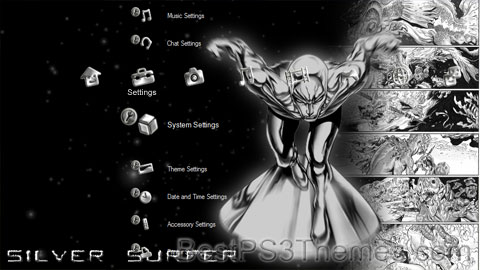
(1 background)
| Silver Surfer | |
|---|---|
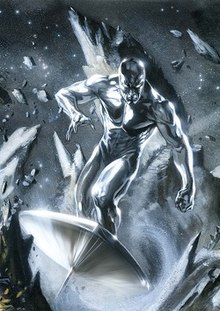 Artwork for the cover of Annihilation: Silver Surfer vol. 4, July, 2006 Art by Gabriele Dell'Otto | |
| Publication information | |
| Publisher | Marvel Comics |
| First appearance | The Fantastic Four #48 (March 1966) |
| Created by | Jack Kirby |
| In-story information | |
| Alter ego | Norrin Radd |
| Species | Zenn-Lavian |
| Place of origin | Zenn-La |
| Team affiliations | |
| Partnerships | Fantastic Four |
| Abilities |
|
The Silver Surfer is a fictional character appearing in American comic books published by Marvel Comics. The character also appears in a number of movies, television, and video game adaptations. The character was created by Jack Kirby and first appeared in the comic book Fantastic Four #48, published in 1966.
The Silver Surfer is a humanoid alien with metallic skin who can travel through space with the aid of his surfboard-like craft. Originally a young astronomer named Norrin Radd on the planet Zenn-La, he saved his homeworld from the planet devourer, Galactus, by serving as his herald. Imbued in return with some portion of Galactus' Power Cosmic,[4] he acquired vast power, a new body and a surfboard-like craft on which he could travel faster than light. Now known as the Silver Surfer, he roamed the cosmos searching for planets for Galactus to consume. When his travels took him to Earth, he met the Fantastic Four, who helped him rediscover his nobility of spirit. Betraying Galactus, he saved Earth but was exiled there as punishment.[5] In the alternate continuity of Earth X and Universe X, Shalla-Bal, Norrin's lover and the empress of Zenn-La, is depicted as joining him as a second Silver Surfer, both serving as the twin-heralds of the second Galactus.
In 2011, IGN ranked the Silver Surfer 41st in its "Top 100 Comic Heroes" list.[6] The Silver Surfer was portrayed by Doug Jones and voiced by Laurence Fishburne in the 2007 film Fantastic Four: Rise of the Silver Surfer.
Jack Kirby commented on the character's creation during an interview stating "My conception of the Silver Surfer was a human being from space in that particular form. He came in when everybody began surfing — I read about it in the paper. The kids in California were beginning to surf. I couldn't do an ordinary teenager surfing so I drew a surfboard with a man from outer space on it."[7]
Kirby further elaborated on the narrative role the character was created as "My inspirations were the fact that I had to make sales and come up with characters that were no longer stereotypes. In other words, I couldn't depend on gangsters, I had to get something new. For some reason I went to the Bible, and I came up with Galactus. And there I was in front of this tremendous figure, who I knew very well because I've always felt him. I certainly couldn't treat him in the same way I could any ordinary mortal. And I remember in my first story, I had to back away from him to resolve that story. The Silver Surfer is, of course, the fallen angel. When Galactus relegated him to Earth, he stayed on Earth, and that was the beginning of his adventures."[8]
Created by Jack Kirby, the character first appears in The Fantastic Four #48 (March 1966), the first of a three-issue arc that fans call "The Galactus Trilogy".[9][10]
The Silver Surfer debuted as an unplanned addition to the superhero-team comic Fantastic Four #48 (March 1966). The comic's writer-editor, Stan Lee, and its penciller and co-plotter, Jack Kirby, had, by the mid-1960s, developed a collaborative technique known as the "Marvel Method": the two would discuss story ideas, Kirby working from a brief synopsis to draw the individual scenes and plot details, with Lee finally adding the dialogue and captions. When Kirby turned in his pencil art for the story, he included a new character he and Lee had not discussed.[11] As Lee recalled in 1995, "There, in the middle of the story we had so carefully worked out, was a nut on some sort of flying surfboard".[12] He later expanded on this, recalling, "I thought, 'Jack, this time you've gone too far'".[13] Kirby explained that the story's agreed-upon antagonist, a god-like cosmic predator of planets named Galactus, should have some sort of herald, and that he created the surfboard "because I'm tired of drawing spaceships!"[14] Taken by the noble features of the new character, who turned on his master to help defend Earth, Lee overcame his initial skepticism and began adding characterization. The Silver Surfer soon became a key part of the unfolding story.[11]
Following the Surfer's debut, Lee and Kirby brought him back as a recurring guest in Fantastic Four #55–61, 72, and 74–77 (ranging Oct. 1966 – Aug. 1968). The character made his solo debut in the backup story of Fantastic Four Annual #5 (Nov. 1967).
Beginning in August 1968, Lee launched the solo title The Silver Surfer.[15] John Buscema was penciller for the first 17 issues of the series, with Kirby returning for the 18th and final issue. The first seven issues, which included anthological "Tales of the Watcher" backup stories, were 72-page (with advertising), 25-cent "giants", as opposed to the typical 36-page, 12-cent comics of the time. Thematically, the stories dealt with the Surfer's exile on Earth and the inhumanity of man as observed by this noble yet fallen hero. Though short-lived, the series became known as one of Lee's most thoughtful and introspective works.[16]
Following his series' cancellation, the Surfer made sporadic appearances as a guest star or antagonist in such comic books as Thor, The Defenders, and Fantastic Four. Lee remained partial to the Surfer, even asking other writers not to use him as a general rule,[17] and with Kirby collaborated on a seminal 1978 graphic novel starring the character, the only original story featured in the Marvel Fireside Books series.[18]
After a 1982 one-shot by writer-artist John Byrne (with scripting by Stan Lee), the Surfer appeared in his second solo ongoing title in 1987.
Initially written by Steve Englehart, the series was to be set on Earth and one issue was completed under this premise before Marvel agreed to let Englehart remove the long-standing restriction regarding Silver Surfer being imprisoned on Earth. This first issue was shelved and a brand new first issue was written, to set up this plot twist; the original first issue would ultimately be reprinted in Marvel Fanfare #51. The series marked the first Silver Surfer stories not written by Stan Lee, a fact which Lee was openly unhappy about. He explained:
After I gave up Spider-Man then someone else did Spider-Man, and someone else did the Fantastic Four and Doctor Strange and the X-Men and all of them. I felt that it was kind of nice for me to have been the only writer of the Silver Surfer, so I felt a little bit disappointed when somebody else did it. I would have liked to have been the only person. Had I known they were absolutely going to have the book done, I would have found the time to do it myself. I didn't really have time but I would have made the time, rather than have anybody else do it. ... this is not at all a criticism of Steve [Englehart] or of Marshall [Rogers, artist on the series], it's just that it's one book that I would have liked to have always done myself. [emphases in original][19]
Englehart introduced many villains for Silver Surfer, as well as featured space politics involving Surfer's homeworld Zenn-La, which was caught in the middle of a renewed Kree–Skrull War. However, issues regarding Englehart wanting to use his Avengers character Mantis as Silver Surfer's companion, as well as editorial refusing to let him use Thanos or other concepts conceived by Jim Starlin, led Englehart to leave the book with issue #31. Starlin took over as writer with issue #34 after several fill-in issues, and incorporated Thanos, Adam Warlock, and Drax the Destroyer into the series.
Under Jim Starlin and later Ron Marz, the series would receive acclaim and sales boost due to Silver Surfer's involvement with Starlin's Infinity Trilogy, with George Pérez and J. M. DeMatteis also having brief writing stints on the series as well. Additional artists included Tom Grindberg, Ron Garney, and Jon J. Muth, as well as periodic guest spots by John Buscema. The title experienced great initial success which allowed Marvel to push the character into other media, including a 1990 video game, 1992 trading card set, and 1998 animated series, as well as spinning off a variety of other comics series including Cosmic Powers, Cosmic Powers Unlimited, Captain Marvel vol. 2, and Star Masters. It ran 146 issues, through 1998. The next year it was followed by the two-issue miniseries, Silver Surfer: Loftier Than Mortals.
A two-issue Silver Surfer miniseries (later collected as Silver Surfer: Parable), scripted by Lee and drawn by Moebius, was published through Marvel's Epic Comics imprint in 1988 and 1989. Because of inconsistencies with other stories, it has been argued that these stories actually feature an alternate Silver Surfer from a parallel Earth.[20] This miniseries won the Eisner Award for best finite/limited series in 1989.
A new ongoing Silver Surfer series began in 2003, focusing on the character's alien nature and messianic allegory. It lasted 14 issues. The Surfer later appeared in an issue of Cable & Deadpool and has been reunited three times with the superhero group the Defenders. In 2006–2007, he starred in the four-issue miniseries Annihilation: Silver Surfer and co-starred in the miniseries Heralds of Galactus, both part of the Annihilation fictional crossover.
In 2007, the Silver Surfer starred in a four-issue miniseries Silver Surfer: Requiem by writer J. Michael Straczynski and artist Esad Ribic. The first issue was released May 30, 2007 to coincide with the character's first movie appearance.[21][22] Published under the Marvel Knights imprint, Silver Surfer: Requiem portrays the character upon learning that he is dying as the silver shell he is encased in is deteriorating.
This was followed by the four-issue miniseries Silver Surfer: In Thy Name,[23] by writer Simon Spurrier[24][25] and artist Tan Eng Huat.[26]
After an appearance in the "Planet Hulk" storyline in 2006, the Surfer was featured in its spin-off series starring the Hulk's son Skaar in 2008, both written by Greg Pak.
The Silver Surfer received a sixth volume, an eponymous 5-issue miniseries written by Pak, debuting in February 2011.[27] He was also a core cast member in The Thanos Imperative (2010), Annihilators (2011),[28] and Fear Itself: The Deep (2011).[29] Beginning in 2011, the Silver Surfer began appearing regularly in The Mighty Thor[30] and a new volume of Defenders,[31] both written by Matt Fraction.
In March 2014, Silver Surfer volume 7 began as part of All-New Marvel NOW! by writer Dan Slott, artist Mike Allred,[32] and colorist Laura Allred.[33] In January 2016 Silver Surfer volume 8 began with a special 50th-anniversary edition expected release in March 2016.[34]
In 2019, a 5-part mini-series titled Silver Surfer: Black was released featuring art from Tradd Moore in collaboration with writing from Donny Cates. The series is an extension of a Guardians of the Galaxy storyline in which the Surfer was sucked into a black hole and ejected into unfamiliar space territory. This run follows the Surfer as he traverses the spaceways on a journey back home.[35]
Silver Surfer later plays an important role in King in Black storyline. With the help from Hugin and Munin, Surfer helps Enigma Force to enter Earth and chose Eddie Brock/Venom as a temporary Captain Universe, to aid his fellow heroes against Knull and his army.[36]
Norrin Radd is from the utopian planet Zenn-La, in the Deneb star system of the Milky Way galaxy. He is the son of Jartran and Elmar Radd, and he has a half-brother, Fennan Radd.[37] Zenn-La's ancient and significantly advanced civilization has lost the will to strive or explore, leaving the young scholar Norrin Radd restless and yearning for adventure. Facing the destruction of his world by planet-consuming Galactus, Radd bargains with the cosmic being. In return for the safety of Zenn-La and his lover, Shalla-Bal, Radd pledges to seek out planets for the world devourer to consume as his herald. Galactus imbues him with a portion of the Power Cosmic, transforming him into the Silver Surfer.[38][39] Radd had intended to lead Galactus to uninhabited planets, but Galactus tampers with his soul to prevent this.[40]
Radd serves Galactus for an unspecified amount of time. Eventually, the Surfer summons his master to Earth. Here the Surfer meets the Fantastic Four and Alicia Masters. Touched by their nobility, he rebels against Galactus, who is eventually driven off. Before he leaves, he confines the Surfer to Earth with an invisible barrier that affects only him.[41][42]
During his exile, the Surfer fights numerous villains, including Doctor Doom, who wants his Power Cosmic, and Mephisto, who wants his soul. The Surfer's only ally during these trials is a physicist by the name of Al B. Harper, who eventually sacrifices himself to save the world from the Stranger.[43]
Banding together with the Hulk and Namor during these wanderings, the Surfer forms the "Titans Three", a group dedicated to battling evil on Earth.[44] Soon, Doctor Strange joins the group and it becomes "The Defenders".[45] Surfer stays with them for a while, but his overwhelming desire to be free of Earth and his frequent collisions with Galactus's energy-draining barrier eventually drives him to leave the group.[volume & issue needed]
The Surfer finally pierces Galactus's barrier with the aid of Reed Richards and temporarily escapes Earth. He discovers, though, that his homeworld has been ravaged by Galactus and Shalla-Bal has been abducted by Mephisto and taken to Earth. Even though it means trapping himself once more, the Surfer returns to Earth to battle and defeat Mephisto. Before being vanquished, Mephisto sends Shalla-Bal back to Zenn-La, but the Surfer manages to endow her with a portion of his Power Cosmic, which she uses to revitalize the plant life of their ravaged homeworld.[46]
After the Surfer aids the Fantastic Four against Galactus's latest herald Terrax,[47] The Surfer eventually pierces Galactus's barrier by acting on a suggestion of trying to pass through on a spaceship instead of via his own power on his surfboard. He also makes peace with Galactus by rescuing current herald Nova from the Skrulls. Galactus declares the Surfer's exile ended.[48] The Surfer immediately revisits his homeworld, but Shalla-Bal, in his absence, had become empress of the rejuvenated Zenn-La and is unable to renew their romance.[49]
Embroiled in fresh hostilities between the interstellar Kree and Skrull empires, the Surfer also intervenes in a series of plots by the Elders of the Universe, who plan to become supremely powerful by destroying Galactus and the universe with him. The Surfer thwarts this plot with the aid of his new love interest, Mantis, the Earth-born cosmic heroine also known as the "Celestial Madonna".[50] She seems to die in the process, and although she eventually returns, she never fully renews their romance.[51] After this loss, a grief-stricken Surfer turns to Nova and romantic feelings begin to develop between them.[52] The Surfer's influence gradually leads Nova to question the morality of her role as herald to Galactus.[53] Eventually replaced by the far more ruthless Morg, Nova dies in a conflict between the new herald and the Surfer and the other ex-heralds.[54]
The Surfer repeatedly battles space-born menaces, the chief of whom is Thanos, who attempts to kill half the life in the universe using the omnipotent Infinity Gauntlet.[55] Through Thanos, the Surfer learns how Galactus had altered his soul. He convinces Galactus to restore it,[56] but once Galactus has done so, the Surfer is overcome with grief until he is able to forgive himself.[57] The Surfer finds interstellar allies in Adam Warlock's Infinity Watch and the "Star Masters" team, and he begins attending occasional Defenders reunions.
The Surfer returns home to Zenn-La to find that the planet has vanished, and learns it was actually destroyed in the 1940s (Earth time) by the entity known as the Other. Zenn-La and its people which the Surfer repeatedly encountered since leaving Galactus's service were actually reproductions, created by Galactus so that the Surfer would have a home to return to.[58] Losing his capacity for emotion again, the Surfer returns to Earth. He later regains his personality during a time-travel adventure and sharing a romance with Alicia Masters.[59] The two ultimately part as friends after many adventures together.
Silver Surfer temporarily bonds with and is controlled by the Carnage symbiote, which is seeking revenge for the destruction of its homeworld.[60]
Later, the Surfer works with the alien Annunaki race to gather and protect some of Earth's most extraordinarily gifted children.[61] In the end, one of these children, Ellie Waters, saves Earth from the godlike Marduk entity, preventing the Apocalypse and reordering reality as if the Marduk crisis had never happened (though Ellie alone apparently retains her memories of these events).[62] The Surfer resumes his interstellar wanderings, but promises to be ready to aid his adopted homeworld should Earth ever need him.
During his travels, the Surfer is captured by a portal of the Sakaar Empire. Left weakened and vulnerable by his trip through the portal, the Surfer is subdued and implanted with an obedience disk to ensure he remains loyal to them. Fighting as a gladiator (and believed to be the fabled 'Sakaarson' due to his appearance), the Surfer is finally forced to face the Hulk along with his Warbound. Through teamwork and distraction, the Hulk is eventually able to destroy the Surfer's obedience disk. The Hulk and several other slaves and gladiators are freed when the Surfer uses the Power Cosmic to remove their own obedience disks and give them a way out of the arena, although the Hulk declines the Surfer's offer to take him back to Earth.[63]
During the Annihilation war, the Silver Surfer again becomes Galactus's herald to help save the universe from the despot Annihilus.[64] Annihilus captures them[65] and gives them to Thanos for experimentation. Drax the Destroyer frees the Surfer, who in turn frees Galactus. An enraged Galactus destroys more than half the Annihilation Wave, and Annihilus is defeated.[66] Later, the Surfer is joined as herald by Stardust, a former herald the Surfer had replaced.[67][68]
The Silver Surfer leads the world devourer to the populated planet Orbucen, which brings him into conflict with Richard Rider. He delays the planetary destruction to give the inhabitants more time to evacuate.[69]
The Silver Surfer returns to Sakaar in a plan to feed Galactus with the unique "Old Power" which he claims would sate his master's hunger for thousands of years, sparing many other inhabited worlds. He is opposed by the Hulk's son, Skaar, and is enslaved by an obedience disc. The conflict is ended when Skaar's mother Caiera sacrifices her soul and Old Power as sustenance for Galactus.[70] Unfortunately, Galactus now seems addicted to the Old Power and has begun searching for other planets containing it to sate himself.[71]
After an encounter with the High Evolutionary,[72] the Silver Surfer and Galactus battled Thor and the Asgardians. The battle ended when the Silver Surfer chose to leave his post as herald and guard an Asgardian artifact. Galactus "tethers" him to Asgard's location in Oklahoma, resulting in his powers waning the further he travels from Asgard, and grants him the ability to return to human form.[73]
During the War with the Serpent, Silver Surfer aids Doctor Strange, Namor, Loa, and Lyra in the liberation of New Atlantis from Attuma, who was transformed into Nerkodd: Breaker of Oceans.[74]
Silver Surfer and Dawn meet Glorian the Maker of Miracles, who plans to rebuild our universe for the heroes to return to after they finish in Battleworld. Glorian has also enlisted the help of the Shaper of Worlds.[75] Glorian then greeted Silver Surfer and Dawn with a tantalizing offer: ally with the Shaper of Worlds to rebuild the universe that was lost. Dawn agreed to use her memories to restore Earth while Silver Surfer left to restore the rest of the universe, but Silver Surfer unmade Galactus while Dawn unknowingly created another version of Norrin. The Shaper of Worlds is not happy with the changes.[76] Dawn and the Surfer embark on more adventures which culminate in their entering a universe predating the main continuity.[volume & issue needed]
When Silver Surfer was displaced in time, he had an encounter with Knull. Silver Surfer was infected by one of Knull's symbiotes only to be saved by Ego the Living Planet. Gathering the energy from the cosmos, Silver Surfer managed to defeat Knull.[77]
During the "King in Black" storyline, Silver Surfer passes by the planets that were ravaged by Knull. At the advice of Thor, Hugin and Munin summon Silver Surfer to Earth.[78] Silver Surfer arrives to where the Enigma Force is and frees it from the symbiotes. Knull reels in pain and Eddie Brock is chosen to be the new Captain Universe.[79] As Silver Surfer faces off against him, Knull recalls his previous fight against him. Through the God of Light, Silver Surfer assumes a chrome form and turns his surfboard into a sword while Knull transforms his armor into one that would enable him to combat Silver Surfer. As Knull begins to fight Silver Surfer, the members of the Avengers, Fantastic Four, and X-Men charge towards Knulls so that they can aid Silver Surfer. Just then, Venom appears having been transformed into Captain Universe stating that he will handle Knull for them. With their weapons separated from the battle axe form following Knull's death, Thor and Silver Surfer noted that things will not be back to normal soon.[80]
The Silver Surfer wields the Power Cosmic, granting him superhuman strength, endurance, and senses and the ability to absorb and manipulate the universe's ambient energy. The Surfer can navigate through interstellar space[81] and hyperspace, which he can enter after exceeding the speed of light allowing traversing interstellar and intergalactic distances to other galaxies millions and even billions of light years away.[82] He has proven capable of time travel on several occasions and can transport other people through time.[83]
The Surfer sustains himself by converting matter into energy; he does not require food, water, air, or sleep, but occasionally enters a sleep-like meditation to dream. He can survive in nearly any known natural environment, including deep space, hyperspace, black holes[84] and stars.[85] The Surfer can project energy in various forms for offensive and defensive use, including force fields, bolts of cosmic force powerful enough to destroy entire planets,[86][87] and create black holes.[86] He can utilize the Power Cosmic to augment his superhuman strength to indeterminate levels.[88] The Surfer can heal both himself and other living organisms, though he cannot raise the dead,[81] and he has proven capable of revitalizing and evolving organic life on a planet-wide scale.[89] He can cast illusions,[90] create interdimensional portals to other locations including microverses,[90] manipulate and phase through solid matter,[81] and exercise some level of control over the astral plane.[91] However, using these abilities results in his becoming greatly weakened, making their use limited.[92]
His senses enable him to detect objects and concentrations of energy light years away and to perceive matter and energy in subatomic detail, including life energies of living beings.[93] The Surfer can even see through time, and can achieve limited perception of past and future events in his general vicinity with concentration.[2] He has demonstrated telepathic ability, including mind-reading,[94] and can influence human emotion and sensation.[81]
The Surfer's board is composed of a nearly impervious, cosmically powered silvery material similar to his own skin. The board is mentally linked to the Surfer and moves in response to his mental commands even when he is not in physical contact with it.[95] The board is nearly indestructible, but on the rare occasions it has been damaged or destroyed, the Surfer can repair or recreate it with little effort.[48] The Surfer can attack opponents by directing the board against them, and the board is capable of temporarily absorbing and imprisoning other beings.[96]
When Galactus exiled the Surfer to Earth, his means of imprisonment was linked to the board. When the Surfer and the Fantastic Four realized this, the Surfer put it to the test by leaving the board planet-side and entering space in the Four's spacecraft. Once he was free of Earth, the Surfer remotely converted the board to energy, recalled it to him, and reformed it in space.[48]
The Surfer has displayed the ability to shed his silver skin and revert to his original appearance as Norrin Radd, masking the Power Cosmic
Fresh theme by Anthony Cook
Download: Fresh.p3t

(1 background)
Fresh may refer to:
Ghost Haxxor theme by GhostHaxxor
Download: GhostHaxxor.p3t

(1 background)
P3T Unpacker v0.12
Copyright (c) 2007. Anoop Menon
This program unpacks Playstation 3 Theme files (.p3t) so that you can touch-up an existing theme to your likings or use a certain wallpaper from it (as many themes have multiple). But remember, if you use content from another theme and release it, be sure to give credit!
Download for Windows: p3textractor.zip
Instructions:
Download p3textractor.zip from above. Extract the files to a folder with a program such as WinZip or WinRAR. Now there are multiple ways to extract the theme.
The first way is to simply open the p3t file with p3textractor.exe. If you don’t know how to do this, right click the p3t file and select Open With. Alternatively, open the p3t file and it will ask you to select a program to open with. Click Browse and find p3textractor.exe from where you previously extracted it to. It will open CMD and extract the theme to extracted.[filename]. After that, all you need to do for any future p3t files is open them and it will extract.
The second way is very simple. Just drag the p3t file to p3textractor.exe. It will open CMD and extract the theme to extracted.[filename].
For the third way, first put the p3t file you want to extract into the same folder as p3textractor.exe. Open CMD and browse to the folder with p3extractor.exe. Enter the following:
p3textractor filename.p3t [destination path]Replace filename with the name of the p3t file, and replace [destination path] with the name of the folder you want the files to be extracted to. A destination path is not required. By default it will extract to extracted.filename.
Folklore theme by David Wales
Download: Folklore_2.p3t

(1 background)
Folklore is the body of expressive culture shared by a particular group of people, culture or subculture.[1] This includes oral traditions such as tales, myths, legends,[a] proverbs, poems, jokes, and other oral traditions.[3][4] This also includes material culture, such as traditional building styles common to the group. Folklore also encompasses customary lore, taking actions for folk beliefs, and the forms and rituals of celebrations such as Christmas, weddings, folk dances, and initiation rites.[3]
Each one of these, either singly or in combination, is considered a folklore artifact or traditional cultural expression. Just as essential as the form, folklore also encompasses the transmission of these artifacts from one region to another or from one generation to the next. Folklore is not something one can typically gain from a formal school curriculum or study in the fine arts. Instead, these traditions are passed along informally from one individual to another, either through verbal instruction or demonstration.[5]
The academic study of folklore is called folklore studies or folkloristics, and it can be explored at the undergraduate, graduate, and Ph.D. levels.[6]
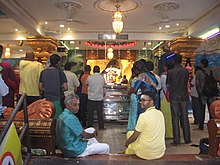


The word folklore, a compound of folk and lore, was coined in 1846 by the Englishman William Thoms,[7] who contrived the term as a replacement for the contemporary terminology of "popular antiquities" or "popular literature". The second half of the word, lore, comes from Old English lār 'instruction'. It is the knowledge and traditions of a particular group, frequently passed along by word of mouth.[8][9]
The concept of folk has varied over time. When Thoms first created this term, folk applied only to rural, frequently poor and illiterate peasants. A more modern definition of folk is a social group that includes two or more people with common traits who express their shared identity through distinctive traditions. "Folk is a flexible concept which can refer to a nation as in American folklore or to a single family."[10] This expanded social definition of folk supports a broader view of the material, i.e., the lore, considered to be folklore artifacts. These now include all "things people make with words (verbal lore), things they make with their hands (material lore), and things they make with their actions (customary lore)".[11] Folklore is no longer considered to be limited to that which is old or obsolete. These folk artifacts continue to be passed along informally, as a rule anonymously, and always in multiple variants. The folk group is not individualistic; it is community-based and nurtures its lore in community. "As new groups emerge, new folklore is created… surfers, motorcyclists, computer programmers".[12] In direct contrast to high culture, where any single work of a named artist is protected by copyright law, folklore is a function of shared identity within a common social group.[13]
Having identified folk artifacts, the professional folklorist strives to understand the significance of these beliefs, customs, and objects for the group, since these cultural units[14] would not be passed along unless they had some continued relevance within the group. That meaning can, however, shift and morph; for example, the Halloween celebration of the 21st century is not the All Hallows' Eve of the Middle Ages and even gives rise to its own set of urban legends independent of the historical celebration; the cleansing rituals of Orthodox Judaism were originally good public health in a land with little water, but now these customs signify for some people identification as an Orthodox Jew. By comparison, a common action such as tooth brushing, which is also transmitted within a group, remains a practical hygiene and health issue and does not rise to the level of a group-defining tradition.[15] Tradition is initially remembered behavior; once it loses its practical purpose, there is no reason for further transmission unless it has been imbued with meaning beyond the initial practicality of the action. This meaning is at the core of folkloristics, the study of folklore.[16]
With the increasing theoretical sophistication of the social sciences, it has become evident that folklore is a naturally occurring and necessary component of any social group; it is indeed all around us.[17] Folklore does not have to be old or antiquated; it continues to be created and transmitted, and in any group, it is used to differentiate between "us" and "them".
Folklore began to distinguish itself as an autonomous discipline during the period of romantic nationalism, in Europe. A particular figure in this development was Johann Gottfried von Herder, whose writings in the 1770s presented oral traditions as organic processes grounded in locale. After the German states were invaded by Napoleonic France, Herder's approach was adopted by many of his fellow Germans, who systematized the recorded folk traditions, and used them in their process of nation building. This process was enthusiastically embraced by smaller nations, like Finland, Estonia, and Hungary, which were seeking political independence from their dominant neighbors.[18]
Folklore, as a field of study, further developed among 19th century European scholars, who were contrasting tradition with the newly developing modernity. Its focus was the oral folklore of the rural peasant populations, which were considered as residue and survivals of the past that continued to exist within the lower strata of society.[19] The "Kinder- und Hausmärchen" of the Brothers Grimm (first published 1812) is the best known but by no means only collection of verbal folklore of the European peasantry of that time. This interest in stories, sayings and songs continued throughout the 19th century and aligned the fledgling discipline of folkloristics with literature and mythology. By the turn into the 20th century the number and sophistication of folklore studies and folklorists had grown both in Europe and North America. Whereas European folklorists remained focused on the oral folklore of the homogenous peasant populations in their regions, the American folklorists, led by Franz Boas and Ruth Benedict, chose to consider Native American cultures in their research, and included the totality of their customs and beliefs as folklore. This distinction aligned American folkloristics with cultural anthropology and ethnology, using the same techniques of data collection in their field research. This divided alliance of folkloristics between the humanities in Europe and the social sciences in America offers a wealth of theoretical vantage points and research tools to the field of folkloristics as a whole, even as it continues to be a point of discussion within the field itself.[20]
The term folkloristics, along with the alternative name folklore studies,[b] became widely used in the 1950s to distinguish the academic study of traditional culture from the folklore artifacts themselves. When the American Folklife Preservation Act (Public Law 94-201) was passed by the U.S. Congress in January 1976,[21] to coincide with the Bicentennial Celebration, folkloristics in the United States came of age.
"…[Folklife] means the traditional expressive culture shared within the various groups in the United States: familial, ethnic, occupational, religious, regional; expressive culture includes a wide range of creative and symbolic forms such as custom, belief, technical skill, language, literature, art, architecture, music, play, dance, drama, ritual, pageantry, handicraft; these expressions are mainly learned orally, by imitation, or in performance, and are generally maintained without benefit of formal instruction or institutional direction."
Added to the extensive array of other legislation designed to protect the natural and cultural heritage of the United States, this law also marks a shift in national awareness. It gives voice to a growing understanding that cultural diversity is a national strength and a resource worthy of protection. Paradoxically, it is a unifying feature, not something that separates the citizens of a country. "We no longer view cultural difference as a problem to be solved, but as a tremendous opportunity. In the diversity of American folklife we find a marketplace teeming with the exchange of traditional forms and cultural ideas, a rich resource for Americans".[22] This diversity is celebrated annually at the Smithsonian Folklife Festival and many other folklife fests around the country.
There are numerous other definitions. According to William Bascom major article on the topic there are "four functions to folklore":[23]


The folk of the 19th century, the social group identified in the original term "folklore", was characterized by being rural, illiterate and poor. They were the peasants living in the countryside, in contrast to the urban populace of the cities. Only toward the end of the century did the urban proletariat (on the coattails of Marxist theory) become included with the rural poor as folk. The common feature in this expanded definition of folk was their identification as the underclass of society.[24]
Moving forward into the 20th century, in tandem with new thinking in the social sciences, folklorists also revised and expanded their concept of the folk group. By the 1960s it was understood that social groups, i.e. folk groups, were all around us; each individual is enmeshed in a multitude of differing identities and their concomitant social groups. The first group that each of us is born into is the family, and each family has its own unique family folklore. As a child grows into an individual, its identities also increase to include age, language, ethnicity, occupation, etc. Each of these cohorts has its own folklore, and as one folklorist points out, this is "not idle speculation… Decades of fieldwork have demonstrated conclusively that these groups do have their own folklore."[12] In this modern understanding, folklore is a function of shared identity within any social group.[13]
This folklore can include jokes, sayings and expected behavior in multiple variants, always transmitted in an informal manner. For the most part it will be learned by observation, imitation, repetition or correction by other group members. This informal knowledge is used to confirm and re-inforce the identity of the group. It can be used both internally within the group to express their common identity, for example in an initiation ceremony for new members. Or it can be used externally to differentiate the group from outsiders, like a folkdance demonstration at a community festival. Significant to folklorists here is that there are two opposing but equally valid ways to use this in the study of a group: you can start with an identified group in order to explore its folklore, or you can identify folklore items and use them to identify the social group.[25]
Beginning in the 1960s, a further expansion of the concept of folk began to unfold through the study of folklore. Individual researchers identified folk groups that had previously been overlooked and ignored. One notable example of this is found in an issue of the Journal of American Folklore, published in 1975, which is dedicated exclusively to articles on women's folklore, with approaches that had not come from a man's perspective.[c] Other groups that were highlighted as part of this broadened understanding of the folk group were non-traditional families, occupational groups, and families that pursued the production of folk items over multiple generations.
Folklorist Richard Dorson explained in 1976 that the study of folklore is "concerned with the study of traditional culture, or the unofficial culture" that is the folk culture, "as opposed to the elite culture, not for the sake of proving a thesis but to learn about the mass of [humanity] overlooked by the conventional disciplines".[26]

Individual folklore artifacts are commonly classified as one of three types: material, verbal or customary lore. For the most part self-explanatory, these categories include physical objects (material folklore), common sayings, expressions, stories and songs (verbal folklore), and beliefs and ways of doing things (customary folklore). There is also a fourth major subgenre defined for children's folklore and games (childlore), as the collection and interpretation of this fertile topic is particular to school yards and neighborhood streets.[27] Each of these genres and their subtypes is intended to organize and categorize the folklore artifacts; they provide common vocabulary and consistent labeling for folklorists to communicate with each other.
That said, each artifact is unique; in fact one of the characteristics of all folklore artifacts is their variation within genres and types.[28] This is in direct contrast to manufactured goods, where the goal in production is to create identical products and any variations are considered mistakes. It is however just this required variation that makes identification and classification of the defining features a challenge. And while this classification is essential for the subject area of folkloristics, it remains just labeling, and adds little to an understanding of the traditional development and meaning of the artifacts themselves.[29]
Necessary as they are, genre classifications are misleading in their oversimplification of the subject area. Folklore artifacts are never self-contained, they do not stand in isolation but are particulars in the self-representation of a community. Different genres are frequently combined with each other to mark an event.[30] So a birthday celebration might include a song or formulaic way of greeting the birthday child (verbal), presentation of a cake and wrapped presents (material), as well as customs to honor the individual, such as sitting at the head of the table, and blowing out the candles with a wish. There might also be special games played at birthday parties which are not generally played at other times. Adding to the complexity of the interpretation, the birthday party for a seven-year-old will not be identical to the birthday party for that same child as a six-year-old, even though they follow the same model. For each artifact embodies a single variant of a performance in a given time and space. The task of the folklorist becomes to identify within this surfeit of variables the constants and the expressed meaning that shimmer through all variations: honoring of the individual within the circle of family and friends, gifting to express their value and worth to the group, and of course, the festival food and drink as signifiers of the event.

The formal definition of verbal lore is words, both written and oral, that are "spoken, sung, voiced forms of traditional utterance that show repetitive patterns."[31] Crucial here are the repetitive patterns. Verbal lore is not just any conversation, but words and phrases conforming to a traditional configuration recognized by both the speaker and the audience. For narrative types by definition have consistent structure, and follow an existing model in their narrative form.[d] As just one simple example, in English the phrase "An elephant walks into a bar…" instantaneously flags the following text as a joke. It might be one you have already heard, but it might be one that the speaker has just thought up within the current context. Another example is the child's song Old MacDonald Had a Farm, where each performance is distinctive in the animals named, their order and their sounds. Songs such as this are used to express cultural values (farms are important, farmers are old and weather-beaten) and teach children about different domesticated animals.[32]
Verbal folklore was the original folklore, the artifacts defined by William Thoms as older, oral cultural traditions of the rural populace. In his 1846 published call for help in documenting antiquities, Thoms was echoing scholars from across the European continent to collect artifacts of verbal lore. By the beginning of the 20th century these collections had grown to include artifacts from around the world and across several centuries. A system to organize and categorize them became necessary.[33] Antti Aarne published a first classification system for folktales in 1910. This was later expanded into the Aarne–Thompson classification system by Stith Thompson and remains the standard classification system for European folktales and other types of oral literature. As the number of classified oral artifacts grew, similarities were noted in items that had been collected from very different geographic regions, ethnic groups and epochs, giving rise to the Historic–Geographic Method, a methodology that dominated folkloristics in the first half of the 20th century.
When William Thoms first published his appeal to document the verbal lore of the rural populations, it was believed these folk artifacts would die out as the population became literate. Over the past two centuries this belief has proven to be wrong; folklorists continue to collect verbal lore in both written and spoken form from all social groups. Some variants might have been captured in published collections, but much of it is still transmitted orally and indeed continues to be generated in new forms and variants at an alarming rate.
Below is listed a small sampling of types and examples of verbal lore.

The genre of material culture includes all artifacts that can be touched, held, lived in, or eaten. They are tangible objects with a physical or mental presence, either intended for permanent use or to be used at the next meal. Most of these folklore artifacts are single objects that have been created by hand for a specific purpose; however, folk artifacts can also be mass-produced, such as dreidels or Christmas decorations. These items continue to be considered folklore because of their long (pre-industrial) history and their customary use. All of these material objects "existed prior to and continue alongside mechanized industry. … [They are] transmitted across the generations and subject to the same forces of conservative tradition and individual variation"[31] that are found in all folk artifacts. Folklorists are interested in the physical form, the method of manufacture or construction, the pattern of use, as well as the procurement of the raw materials.[34] The meaning to those who both make and use these objects is important. Of primary significance in these studies is the complex balance of continuity over change in both their design and their decoration.
In Europe, prior to the Industrial Revolution, everything was made by hand. While some folklorists of the 19th century wanted to secure the oral traditions of the rural folk before the populace became literate, other folklorists sought to identify hand-crafted objects before their production processes were lost to industrial manufacturing. Just as verbal lore continues to be actively created and transmitted in today's culture, so these handicrafts can still be found all around us, with possibly a shift in purpose and meaning. There are many reasons for continuing to handmake objects for use, for example these skills may be needed to repair manufactured items, or a unique design might be required which is not (or cannot be) found in the stores. Many crafts are considered as simple home maintenance, such as cooking, sewing and carpentry. For many people, handicrafts have also become an enjoyable and satisfying hobby. Handmade objects are often regarded as prestigious, where extra time and thought is spent in their creation and their uniqueness is valued.[35] For the folklorist, these hand-crafted objects embody multifaceted relationships in the lives of the craftspeople and the users, a concept that has been lost with mass-produced items that have no connection to an individual craftsperson.[36]
Many traditional crafts, such as ironworking and glass-making, have been elevated to the fine or applied arts and taught in art schools;[37] or they have been repurposed as folk art, characterized as objects whose decorative form supersedes their utilitarian needs. Folk art is found in hex signs on Pennsylvania Dutch barns, tin man sculptures made by metalworkers, front yard Christmas displays, decorated school lockers, carved gun stocks, and tattoos. "Words such as naive, self-taught, and individualistic are used to describe these objects, and the exceptional rather than the representative creation is featured."[38] This is in contrast to the understanding of folklore artifacts that are nurtured and passed along within a community.[e]
Many objects of material folklore are challenging to classify, difficult to archive, and unwieldy to store. The assigned task of museums is to preserve and make use of these bulky artifacts of material culture. To this end, the concept of the living museum has developed, beginning in Scandinavia at the end of the 19th century. These open-air museums not only display the artifacts, but also teach visitors how the items were used, with actors reenacting the everyday lives of people from all segments of society, relying heavily on the material artifacts of a pre-industrial society. Many locations even duplicate the processing of the objects, thus creating new objects of an earlier historic time period. Living museums are now found throughout the world as part of a thriving heritage industry.
This list represents just a small sampling of objects and skills that are included in studies of material culture.
Customary culture is remembered enactment, i.e. re-enactment. It is the patterns of expected behavior within a group, the "traditional and expected way of doing things"[39][40] A custom can be a single gesture, such as thumbs down or a handshake. It can also be a complex interaction of multiple folk customs and artifacts as seen in a child's birthday party, including verbal lore (Happy Birthday song), material lore (presents and a birthday cake), special games
Michelle Marsh & Lucy Pinder versionD theme by Deemy
Download: MichelleMarshLucyPinder_vD.p3t

(8 backgrounds)
P3T Unpacker v0.12
Copyright (c) 2007. Anoop Menon
This program unpacks Playstation 3 Theme files (.p3t) so that you can touch-up an existing theme to your likings or use a certain wallpaper from it (as many themes have multiple). But remember, if you use content from another theme and release it, be sure to give credit!
Download for Windows: p3textractor.zip
Instructions:
Download p3textractor.zip from above. Extract the files to a folder with a program such as WinZip or WinRAR. Now there are multiple ways to extract the theme.
The first way is to simply open the p3t file with p3textractor.exe. If you don’t know how to do this, right click the p3t file and select Open With. Alternatively, open the p3t file and it will ask you to select a program to open with. Click Browse and find p3textractor.exe from where you previously extracted it to. It will open CMD and extract the theme to extracted.[filename]. After that, all you need to do for any future p3t files is open them and it will extract.
The second way is very simple. Just drag the p3t file to p3textractor.exe. It will open CMD and extract the theme to extracted.[filename].
For the third way, first put the p3t file you want to extract into the same folder as p3textractor.exe. Open CMD and browse to the folder with p3extractor.exe. Enter the following:
p3textractor filename.p3t [destination path]Replace filename with the name of the p3t file, and replace [destination path] with the name of the folder you want the files to be extracted to. A destination path is not required. By default it will extract to extracted.filename.